Dong Ho painting village, a longstanding cultural heritage site with a history of over 400 years, is an appealing destination for those who want to learn about the traditional art of the Vietnamese people. The village’s fame largely stems from its unique Dong Ho paintings, which vividly depict the cultural identity of our ancestors. In this article, let’s explore the distinctive features of Dong Ho painting village together with DanangPrivateCar.Com.
Table of Contents
The Beauty of Dong Ho Painting Village
- Address: Song Ho Commune, Thuan Thanh District, Bac Ninh Province
Dong Ho folk paintings, also known as Dong Ho woodcut paintings, are among the most famous traditional art forms in Vietnam. Originating from Dong Ho village, Bac Ninh province, Dong Ho paintings are renowned for their uniqueness and meticulousness in every stroke, becoming a source of pride for our people.
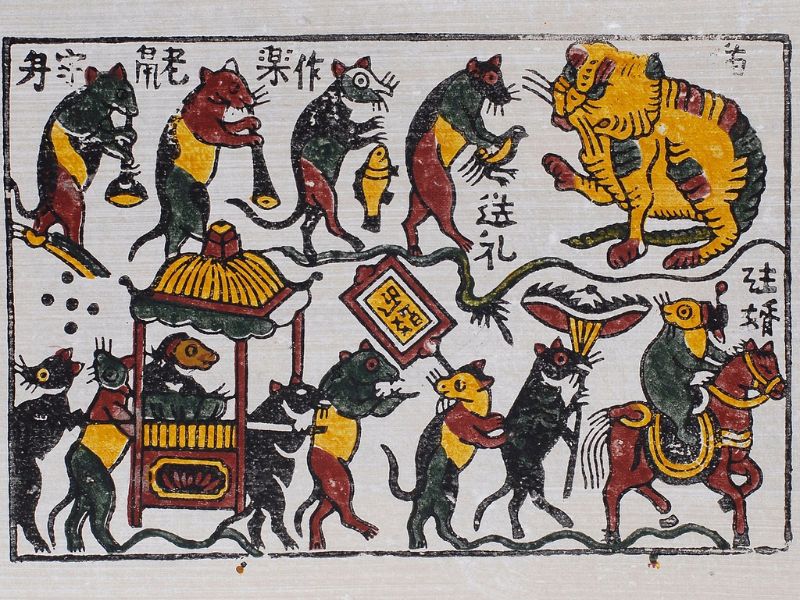
Dong Ho Painting Village is situated along the Duong River, in Song Ho Commune, Thuan Thanh District, Bac Ninh Province, approximately 16km from the city center of Bac Ninh. This location is also known as Dong Ho Hanoi Painting Village, being only about 35km from Hanoi. Today, Dong Ho Painting Village serves both as a hub for producing outstanding artistic paintings and as a tourist destination attracting many visitors for appreciation and exploration.
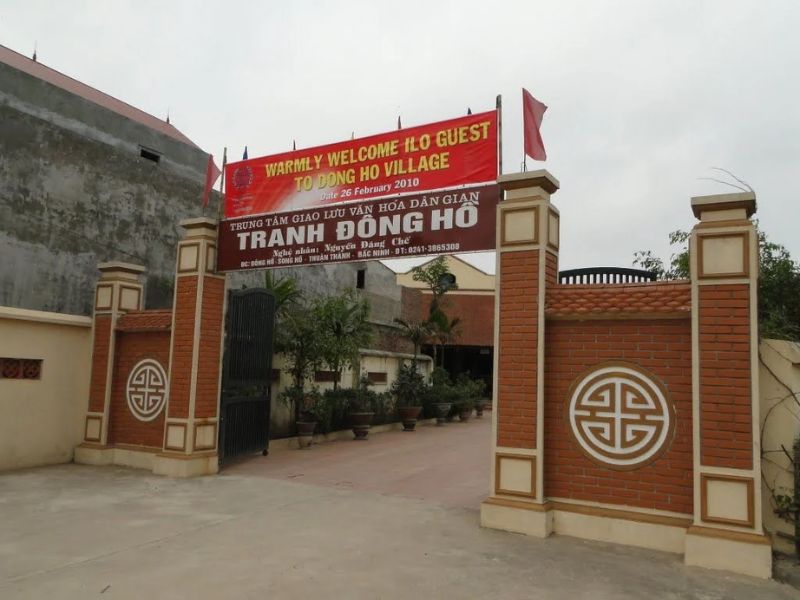
Dong Ho Painting Village still retains its traditional features
With over 400 years of history, Dong Ho Painting Village boasts more than 17 ancestral lines specializing in traditional woodcut painting. Dong Ho woodcut artists are highly esteemed for their expertise and exquisite craftsmanship. With impressions of longevity and talent in painting, visitors often come to experience the traditional atmosphere and culture of Dong Ho Painting Village.
Today, although Dong Ho Village has shrunk in scale to about 220 households, it remains a place preserving the unique essence of traditional Dong Ho painting, making it the most distinctive in our country.
The historical story of the traditional painting village in Kinh Bac region
Dong Ho Painting Village, with a history of over 400 years, is famous for producing Dong Ho folk woodcut paintings – an icon of Vietnamese culture and history. The people here maintain the traditional method of handcrafted woodcut painting since the 16th century.

In particular, Dong Ho Painting Village experienced significant development from the late 18th century until 1944 with the contribution of 17 ancestral lines within the village. However, during the resistance against the French colonialists, the village faced many difficulties, resulting in the destruction of the village and interruption in the painting craft. By 1967, with peace established in the North, Dong Ho Painting Village began its journey of restoration.

In the past, Dong Ho Painting Village used to hold painting markets during the Lunar New Year, attracting many buyers and curious tourists eager to admire woodcut paintings. However, after the 1940s, the painting craft in the village began to decline due to reduced market demand. This trend continued into the 1990s when the Dong Ho Painting Cooperative was dissolved, and many families switched to other trades.
As of March 2013, the Dong Ho painting craft was recognized as a national intangible cultural heritage in urgent need of protection. Although not as prominent as before, the value of Dong Ho paintings still attracts many art lovers and maintains its vitality to this day.
Discovering Dong Ho Painting Village
Best Time to Visit for “Painting Appreciation”
For the best experience when visiting Dong Ho Painting Village, you can come and explore any day of the week. Typically, from the first to the third lunar months is considered the ideal time to visit the village because the weather is relatively mild and cool, allowing you to fully appreciate the unique features of the village.
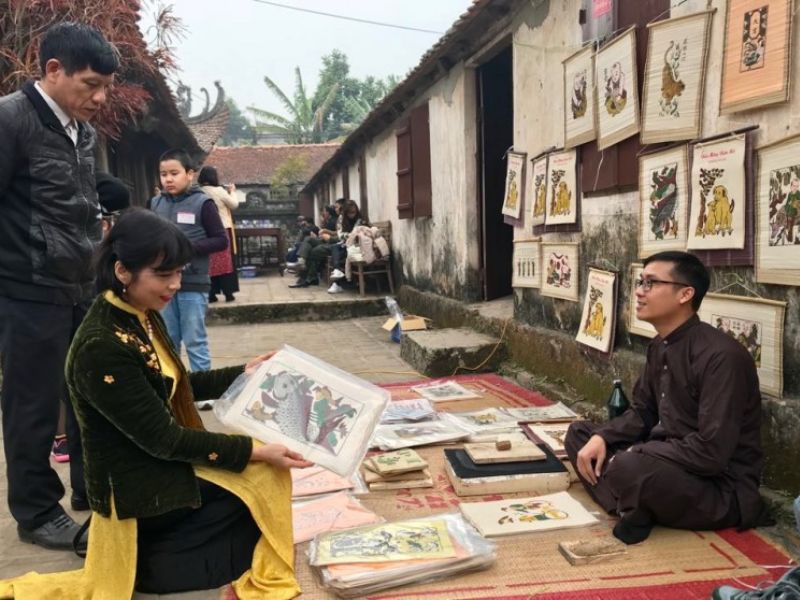
The most suitable visiting hours are in the morning from 9 am to 11 am and in the afternoon from 2 pm to 5 pm. During this time, you can enjoy the peaceful atmosphere of the village, visit the workshops of artisans, and appreciate the traditional beauty of Dong Ho paintings.
Getting to Dong Ho Painting Village
Dong Ho Folk Painting Village is located in Song Ho Commune, Thuan Thanh District, Bac Ninh Province, approximately 35km from the center of Hanoi, situated on the southern bank of the Duong River. To get to the painting village, you have several transportation options:
- Bus route 204 (Hanoi – Thuan Thanh, Bac Ninh): The route starts from Long Bien transfer point, passing through Nguyen Van Long, National Highway 5, Phu Thi Intersection, Sui Street, Chua Keo, Duc Hiep, Thanh Hoai, Tam A, then to Ho town (Thuan Thanh). From Ho town, you can use a motorbike taxi to travel a few kilometers more to reach Dong Ho Painting Village.
- Private transportation (motorbike, car, etc.): Follow National Highway 5 until near Phu Thi Intersection, then turn left onto National Highway 18B. Continue through Sui Market, Keo Market, Dau Market, then turn left onto the dike road. After about 3km, you will arrive at Dong Ho Painting Village. You can also choose the route from Dau Market, then go straight to Ho town, then turn left onto National Highway 38. When nearing Ho Bridge, turn left onto Thien Duc Street, continue straight for about 2km, and you will reach Dong Ho Folk Painting Village.
- Private car service with driver: For the most convenient way to visit Dong Ho Painting Village, book a private car with a driver in Hanoi from DanangPrivateCar.com. Our professional drivers will ensure you have the safest and most comfortable trip.
What to Do When Visiting Dong Ho Painting Village?
Admire the Unique Paintings
Dong Ho village paintings are popular art pieces for their ability to depict familiar themes related to rural life and the everyday lives of Vietnamese people. Dong Ho artisans know how to utilize and transform raw materials from nature to create traditional colors, which are not only vibrant but also highly durable. For example, the colors derived from the leaves of the Cham tree, bright red from the bark of the Van tree, black from the ash of bamboo leaves or Voan ash…
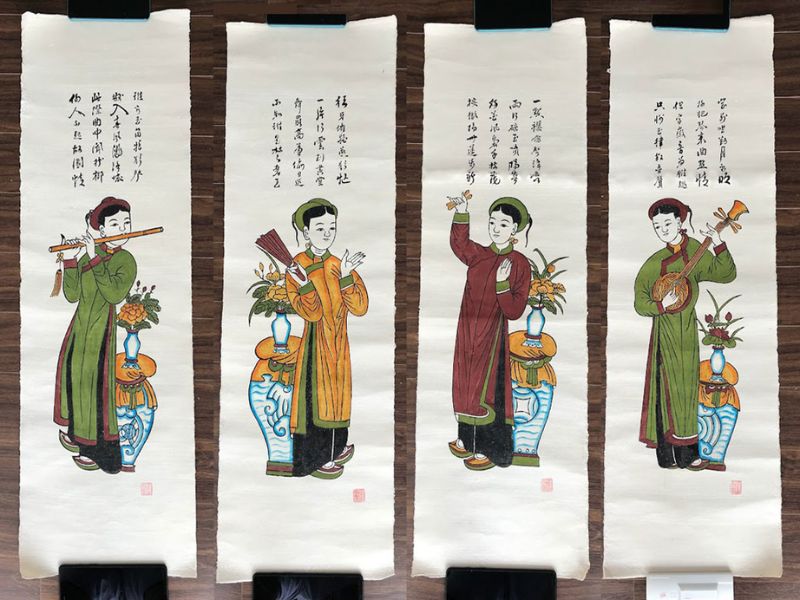
These unique paintings are often printed on Do paper, a handmade paper produced from Do trees naturally grown in the forest. The paper background is usually coated with a layer of resin or a layer of Ho resin containing a small amount of powder from the clamshell to create a shiny surface. Therefore, Do paper is also known as Diep paper, characterized by its natural beauty and delicacy.
Participate in the Dong Ho Folk Painting Festival
If you have the opportunity to visit during the lunar dates from the 14th to the 16th of the third month, you will participate in a unique and exciting experience with the painting festival. Every year, the painting festival in Thuan Thanh, Bac Ninh attracts a large number of tourists to enjoy the lively atmosphere and colors of the countryside festival.
Additionally, Dong Ho Painting Village also hosts a distinctive painting market during the Lunar New Year, with five sessions taking place on the 6th, 11th, 16th, 21st, and 26th. From early morning, you can see excited crowds heading to Dong Ho village, creating a lively atmosphere like a traditional festival. Many people come to the market not only to buy and sell paintings but also to appreciate the unique artworks of Dong Ho village.
Create Your Own Dong Ho Painting
When visiting Dong Ho Painting Village, you can immerse yourself in the process of making Dong Ho paintings, an interesting experience that requires delicacy and high technique. This journey is divided into three main stages, starting with creating the painting pattern. Here, you will choose the theme, significance, layout, and colors for your painting. Using a brush pen and Chinese ink, you will create a sample painting on thin and flat paper, which will then be used for woodcutting.

Next is the woodcutting stage, where each color in the sample painting requires a separate woodcut. You will use wood made from the Thi or Thung tree, which has multidimensional fibers to create softness for the painting and facilitate the woodcutting process. Using a set of 30-40 hard steel chisels, you will create small and intricate details on the wood.
The printing process is the next step, where you will dip the sponge made from pine needles into the dyeing pot. The sponge is evenly brushed onto the paper surface and the wood for printing. You will place the wood onto the paper and press down to ensure even dyeing. Then, the printed wood will be lifted, and the painting will be removed from the wood. The painting will then be air-dried, and the printing process will be repeated until all colors are added. The black outline is usually printed last.
Buy Dong Ho Paintings as Gifts
When visiting and touring Dong Ho Folk Painting Village, an unmissable gift to bring back for loved ones or friends is traditional woodcut paintings. Additionally, Dong Ho village displays many souvenir items with a unique Dong Ho painting style that you can browse and purchase as special mementos.
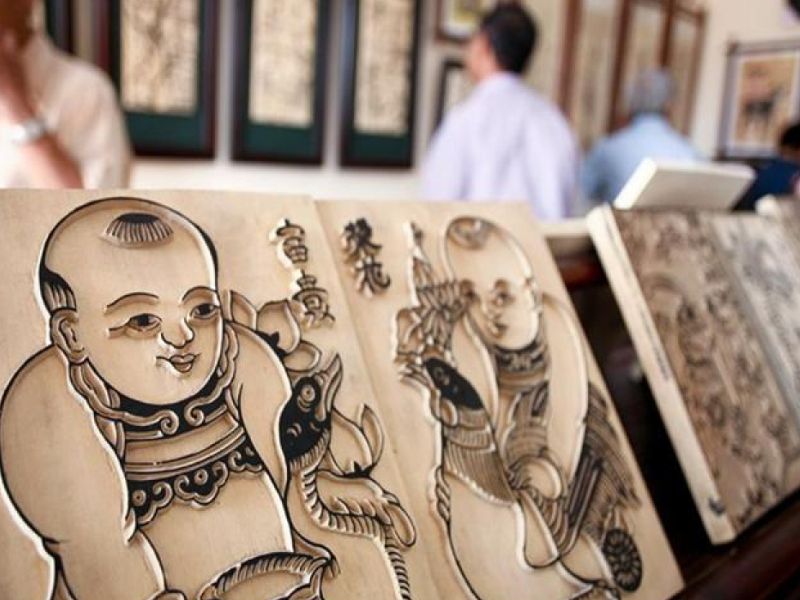
Some tips when visiting Dong Ho Painting Village
Exploring Dong Ho Painting Village is an incredibly interesting experience, immersing you in the unique culture of the Kinh Bac region. To have a perfect trip, consider the following points:
- Clothing: Choose comfortable yet modest clothing suitable for visiting Dong Ho Painting Village, especially if your travel plans also include visiting nearby temples and pagodas.
- Traffic safety: If traveling by motorbike, pay attention and drive carefully, especially on the dyke roads where traffic accidents may occur.
- Research beforehand: Before visiting Dong Ho Village, research information about the village on websites to gain an overview and prepare well for your trip.
- Maintain silence: Dong Ho Painting Village offers a peaceful, tranquil space, entirely different from the hustle and bustle of the city. Therefore, cherish and maintain this tranquility.
- Product pricing: Products in Dong Ho Painting Village are guaranteed in quality, so you don’t have to worry about counterfeit or fake goods. Each painting is a delicate work of art by artisans, so prices typically range from 20,000 VND to 150,000 VND per painting.
Above are the distinctive features of Dong Ho Painting Village that you can include in your Hanoi and Bac Ninh travel guide. DanangPrivateCar.com believes that taking the time to visit here will evoke pride in the culture and history of the nation.

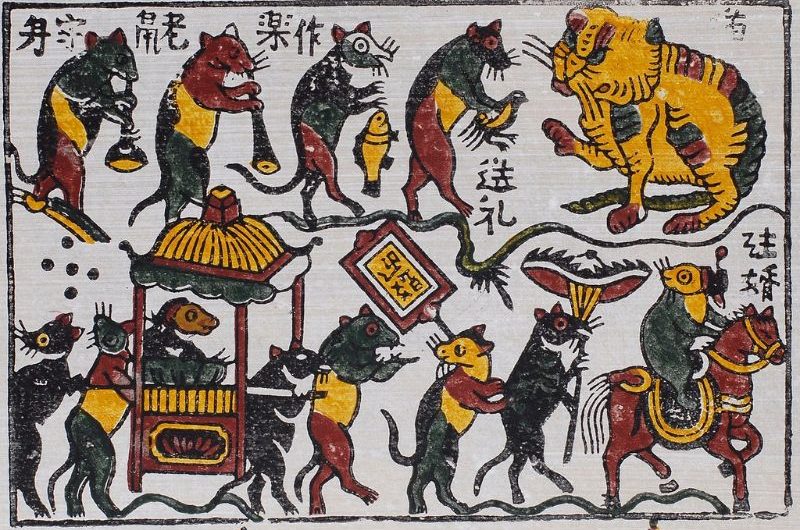
Comments